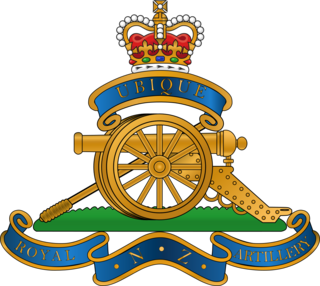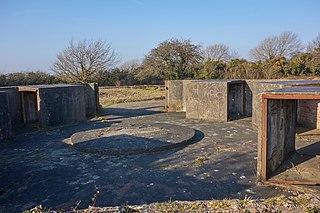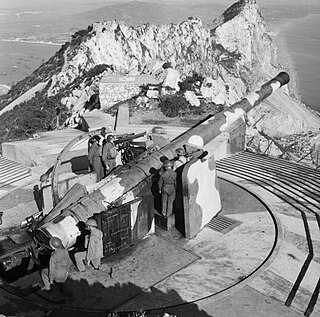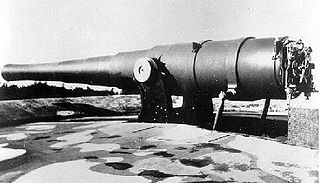History
Since the First World War, the coastal defences of Lyttelton had come under a single battery, 23 Heavy Battery (23 Coast Battery prior to 1934). In March 1940, 23 Heavy Battery was broken up into three batteries and the overall force increased in manpower. The 11th Heavy Regiment was formed in July 1940 to command the Lyttelton defence batteries, which included both coastal artillery and anti-aircraft artillery. In 1941, the regiment was expanded to include the coastal artillery batteries which covered other ports in the South Island, however in May 1943, 82, 141 and 142 batteries were detached and become 13th Coast Regiment. These batteries returned in December when 13th Coast Regiment was disbanded. At its peak size in 1943, the regiment consisted of nine batteries: [2]
The name of the regiment was changed to 11th Coast Regiment in October 1944 and in the same year, the coastal defences were effectively mothballed. After the war it was decided that only the defences at Lyttelton should be kept in an operational state by a small peacetime garrison. In 1948 the territorial force was reorganised. All the New Zealand Artillery became part of the Royal New Zealand Artillery and the batteries were renumbered as:
- 111 Battery (Battery point)
- 112 Battery (Godley Point)
- 113 Battery (Battery point)
It was decided in 1957 that the coastal artillery regiments were no longer necessary. The armament and equipment were placed on a care and maintenance basis, while the regiment was reduced to a cadre. Over the coming years, the equipment was scrapped and much of the facilities and land were sold off. The regiment eventually dropped to a single quartermaster sergeant, but continued to exist on paper until it was formally disbanded in 1967.

The New Zealand Army is the principal land warfare force of New Zealand, a component of the New Zealand Defence Force alongside the Royal New Zealand Navy and the Royal New Zealand Air Force.

The Royal Regiment of New Zealand Artillery is the artillery regiment of the New Zealand Army. It is effectively a military administrative corps, and can comprise multiple component regiments. This nomenclature stems from its heritage as an offshoot of the British Army's Royal Artillery. In its current form it was founded in 1947 with the amalgamation of the regular and volunteer corps of artillery in New Zealand. In 1958 in recognition of services rendered it was given the title the Royal Regiment of New Zealand Artillery.

Wrights Hill Fortress is a counter bombardment coastal artillery battery in the Karori suburb of Wellington, New Zealand. It was built between 1942 and 1944 and is predominantly underground, with numerous tunnels linking the war shelters, gun emplacements, magazines, plotting rooms and engine room – which are, at some points, over 50 feet underground. The fort was intended to house three 9.2" Mk. XV guns, but only two guns were installed and the fort never saw action. After World War II was over, fort commanders fired both of the guns. The fall of the shot was observed in Cook Strait and these test firings were deemed a success. In 1960, somewhat ironically, both of the guns were sold to the Japanese as scrap metal, the very nation Wrights Hill Fortress was constructed to defend Wellington against. The design of the fort is similar to the Stony Batter and Whangaparāoa 9.2" Mk. XV batteries, near Auckland.

Lavernock Battery was built at Lavernock Point, Wales on the recommendations of the 1860 Royal Commission during the late 1860s to protect the ports of the Severn Estuary. It was replaced by a new anti-aircraft battery during World War II that was equipped with four heavy anti-aircraft guns.

The Sri Lanka Artillery (SLA) is the artillery arm of the Sri Lanka Army. It is made up of ten regular regiments and two volunteer regiments. The SLA is headquartered at Panagoda Cantonment, Panagoda.

The BL 6-inch gun Mark VII was a British naval gun dating from 1899, which was mounted on a heavy travelling carriage in 1915 for British Army service to become one of the main heavy field guns in the First World War, and also served as one of the main coast defence guns throughout the British Empire until the 1950s.

Coastal fortifications were constructed in New Zealand in two main waves: around 1885 as a response to fears of an attack by Russia, and in World War II due to fears of invasion by the Japanese.

The following is a List of Coastal Batteries in Australia and Territories during World War II. The main threat came early in the war from German raiders and threat of Japanese raids or invasion, and hence all available ordnance was pressed into service, including some obsolete guns and field guns adapted for coast defence.

The BL 9.2-inch Mk IX and Mk X guns were British breech loading 9.2-inch (234 mm) guns of 46.7 calibre, in service from 1899 to the 1950s as naval and coast defence guns. They had possibly the longest, most varied and successful service history of any British heavy ordnance.

The BL 9.2-inch Mk I–VII guns were a family of early British heavy breechloading naval and coast defence guns in service from 1881 to the end of World War I. They were originally designed to use the old gunpowder propellants.

Fort Nepean is a former defensive facility occupying part of Point Nepean, Victoria, Australia. It was part of a network of fortifications, commanded from Fort Queenscliff, protecting the narrow entrance to Port Phillip. It is now part of Point Nepean National Park and a local tourist attraction.

The 13th Coast Regiment, New Zealand Artillery was a coastal artillery regiment of the New Zealand Military Forces. It was formed in May 1943 from the coastal defence batteries based in the lower South Island, which were formerly part of 11th Coast Regiment. The regiment consisted of:
Barrett Point is located at the foot of Mount Hayes at the entrance to Prince Rupert Harbour at 54°14′28″N130°20′02″W. It was a coastal fortification during World War II.

The 120th Light Anti-Aircraft Regiment, was an air defence unit of the British Army's Royal Artillery during World War II. It landed on D-Day and saw action throughout the campaign in North West Europe, defending the vital Scheldt Estuary until the end of the war.

The 2nd Devonshire Artillery Volunteers was a unit of the British Volunteer Force and Territorial Army. The unit and its successors defended Plymouth Dockyard and the Devon coast from 1861 to 1961.

Leighton Battery at Buckland Hill, Mosman Park, Western Australia, was part of the Coastal defences of Australia during World War II and the Fremantle Fortress, protecting Fremantle Harbour.

Fremantle Fortress was the combined coastal defences protecting the harbour of Fremantle, Western Australia, since the mid-1930s and, predominantly, during World War II. The coastal defences of the Fremantle Fortress stretched along the coastline of Perth from Cape Peron to Swanbourne and also included installations on Garden Island and Rottnest Island. While the first coastal batteries of the future Fremantle Fortress were installed at Arthur Head in 1906, the military installations protecting the harbour were expanded in the 1930s, being eventually dismantled again by 1963.

The 10th Coast Regiment, Royal New Zealand Artillery was a territorial coastal artillery regiment of the New Zealand Army. The regiment was formed in 1940 as 10th Heavy Regiment, New Zealand Artillery and controlled the coastal defence batteries around Wellington Harbour. The regiment was progressively expanded and by the end of the war had batteries all over the lower North Island. The regiment was reduced to a cadre in 1957 and disbanded in 1967, along with the other coastal artillery regiments.

The 9th Coast Regiment, Royal New Zealand Artillery was a territorial coastal artillery regiment of the New Zealand Army. The regiment was formed in 1940 as 9th Heavy Regiment, New Zealand Artillery and controlled the coastal defence batteries around Auckland. The regiment was progressively expanded and by the end of the war had batteries all over the upper North Island. The regiment was reduced to a cadre in 1957 and disbanded in 1967, along with the other coastal artillery regiments.

The 6th Light Anti-Aircraft Regiment, Royal New Zealand Artillery was a territorial air defence regiment of the New Zealand Army. It was formed in 1948 and equipped with 40mm Bofors anti-aircraft guns. The regiment was disbanded in 1961.















